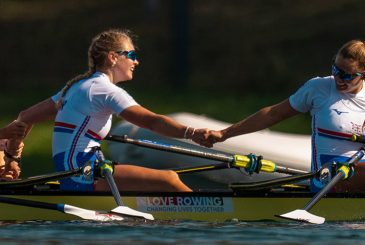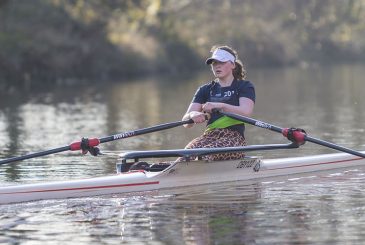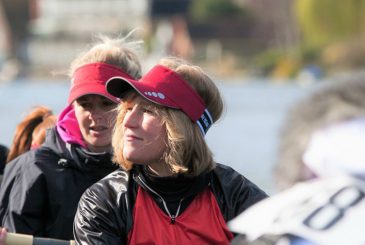Have you thought about setting New Year’s resolutions related to your rowing? Need some inspiration? JRN asked members of the junior and student rowing community what they’ll be focusing on as they head into next year and provided a little guidance on how to go about achieving them
Top tips
Tip 1: We all know that most New Year’s resolutions don’t last beyond the first few weeks of January. At the end of this article you’ll find some practical ideas for what you can do to ensure they keep motivating you throughout the year.
Tip 2: To be effective, make sure your New Year’s Resolutions are SMART.
Resolution: Go below seven minutes/eight minutes on a 2km ergo
For many, ergo results are the holy grail of the sport. And we all know that the 2km row is the ultimate test of strength, both physically and mentally. The constant struggle to shave that score down by seconds or metres is an ongoing narrative within each rower’s training plan.
How to achieve it
It’s easy to set your sights on going below a certain threshold i.e. seven minutes for a boy or eight minutes for a girl, which both represent very competent scores.
Like most ergo pieces, the best way to approach this goal is with structure and a clear pathway to achieving the score you want. Give yourself at least eight weeks from starting the journey to seeing notable improvements in your scores. Factor other training methods – weights, cardio, cross-training – into your program to help condition varying muscle groups, as the ergo will test them all.
Resolution: Learn how to foot steer
Steering with your foot is a difficult ask for any rower. A race demands so much from an athlete before you factor in trying to navigate the course using one foot attached to the stretcher. However, when you master it, you become indispensable to your squad, particularly if you scull/mainly train and race in smaller boats.
How to achieve it
Again, you should start on your local lake or stretch of river and set expectations accordingly with your crew-mates – explain that for this session and several more, you’ll be focusing on getting your lines right, adjusting to the touch of the rudder and how it responds to your foot. Don’t be afraid of turning your head at the beginning to check you’re in the right place – you can recover your rhythm pretty quickly. As you progress, you’ll start to notice landmarks on your water that tip you off as to your positioning and you’ll need to turn a lot less.
Resolution: Never skip the core workout
The oldest trick in the book. Rowers have long focused on the training that gives us the greatest sense of immediate gratification i.e. a really tough ergo or a long, lonely session in the single. But building a robust set of core muscles is critical to evolving your technique and strength though and should not be neglected. Stretching is another component of exercise that is often overlooked to a rower’s detriment. Your muscle groups need different types of stimulation to grow and develop and a core workout – perhaps incorporating exercises across the body – is a really important part of the program in that respect. Plus, it’s nice to get the chance not to stare at a screen or the back of someone’s head for once…
How to achieve it
If you have to miss formal core sessions at your club, core workouts are easy to do at home. Just find a bit of space and hit play on this video from Olympic medallist Vicky Thornley. There are more useful workouts here.
Resolution: Don’t stop even if you don’t see the splits you want
This is such an important one and actually leans towards a broader point around not giving up in spite of what your brain – and perhaps your screen – is showing. Of course, it’s important to always be aware of what your body is telling you if you’re injured, unwell or struggling with something specific, it can be very helpful to pause and understand what the issue is and whether continuing is likely to improve that. However, we all have off days where we just can’t work out what the issue is – it can feel like, no matter how hard we try, the numbers on the ergo screen won’t fall to where we want them. This is very normal and an important benchmark in your training program – fighting through that mental block, even if you never see your splits rebound, is hugely significant and will enable greater performance in the future.
How to achieve it
Remind yourself that each stroke is part of the process, be it a good one or a bad one – what is important is that you’re there, committing to the session and to consistent improvement.
Resolution: Race on the Henley waters
For many athletes in the UK, and perhaps even further afield, going afloat on the Henley reach is amongst the most fulfilling moments in their career. The series of rowing events that occur at Henley through the summer months – beginning with Henley Women’s Regatta in mid-June and typically culminating in Henley Town and Visitors at the end of July – are some of the best racing opportunities available to clubs, school and universities and naturally represent a real aim for our community.
How to achieve it
It’s worth checking in with your coach on whether they share your ambition and explaining that this is what you want to do and that you’d like their help. You’ll need to plan in interim steps such as racing a big regattas against the type of opposition you can expect to meet there. Even if you don’t manage to make it to the events this year, go and visit – it will provide plenty of motivation for 2024 and beyond.
How to stick to your New Year’s resolutions resolutions
New Year’s resolutions feel like such a smart idea at 11:59pm on the 31st December but often seem more remote a few minutes after midnight during the post-firework and celebration lull, never mind a few weeks into a cold, wet January. And this is true even for competitive rowers.
One of the best ways to stick to New Year’s resolutions (or any goal, for that matter), is to make yourself accountable by telling someone else about it. So head over to our social channels on Instagram, Facebook or Twitter and commit to the rowing community about what you want to achieve in a boat this year by replying to our posts about this article! Or, you could keep it local and offline by setting up a New Year’s resolutions: Rowing edition poster on your club noticeboard for your squad or even the whole club.










